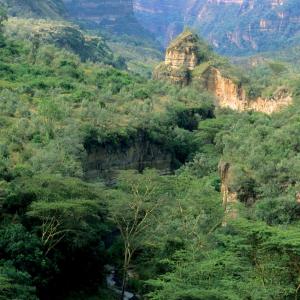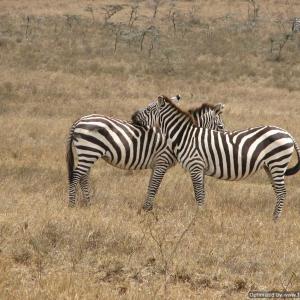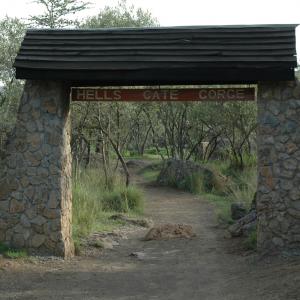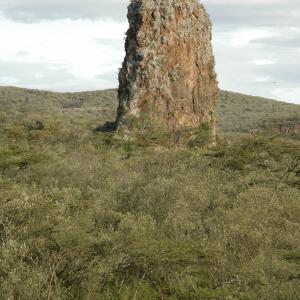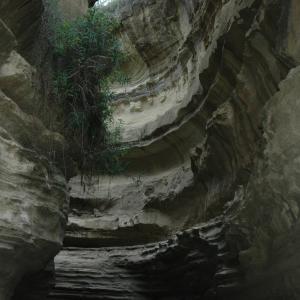``A living volcanic arena``
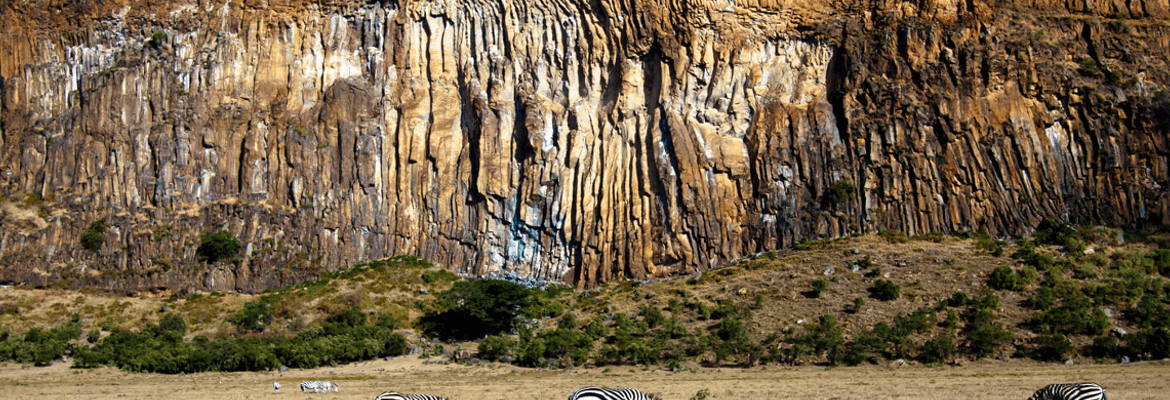
Despite its rather alarming title, Hell’s Gate National Park provides the ideal venue for a day trip from Nairobi, a truly panoramic picnic spot, or an evocative camping stopover. Cleft deep into the floor of the Great Rift Valley, this relatively small Park provides endless bio-diversity and is one of only two Kenyan Parks to allow walking or cycling without an official KWS escort (the other being Saiwa Swamp National Park). As for the scenery, the towering cliffs, water-gouged gorges, stark rock towers, scrub-clad volcanoes and belching plumes of geothermal steam make it one of the most atmospheric Parks in Africa.
Kenya Safari Fact File
Altitude: 1,560-2,187 m above sea level.
Area: 68 sq km.
Location: Nakuru District, Rift Valley Province.
Distance from Nairobi: 100 km north-west of Nairobi.
Opened: February 1984.
Climate: January-March hot and dry. April-June hot and wet. July-October very warm and dry. November and December warm and wet.
Vegetation: Mainly grassland and shrub (dominated by Leleshwa and several varieties of acacia).
Wildlife: Eland, buffalo, lion, giraffe, zebra, leopard, impala, Grant’s and Thomson’s gazelle, klipspringer, hyrax and mountain reedbuck.
Birds: More than 100 species of birds have been recorded including numerous rare birds.
Prehistory: Hell’s Gate is believed to be the outlet of a prehistoric freshwater lake, which once stretched all the way to Nakuru, and on whose shores a number of early human communities are believed to have lived.
Special interest: Hell’s Gate National Park has been designated a World Heritage Site and enjoys global protection as one of the most unique natural sites on earth.
Roads: The roads of the main Park circuit are accessible all year round with 2WD. 4WD is required to tour some of the less travelled circuits.
Visitor note: There is a KWS (official custodians of the Kenya National Parks & Reserves) retail outlet at Elsa Gate where you can obtain water, maps of the Park and a wide range of gifts and souvenirs.
Activities: rock climbing, mountain biking, trail hiking, bird watching, walking and nature trails
What to see and do
The best time for wildlife viewing is at dawn, when most of the animals are in evidence; try to avoid the mid-day hours if you can, because the Park can become intensely hot. Rock climbing, walking, mountain biking, nature trails, bird watching and driving tours are all highly recommended, especially since the Park offers unrivalled views of the Aberdare Range, Lake Naivasha and Mount Longonot. The evocative scenery has also been used in a number of films, most recently in the 1980 Hollywood film, ‘Sheena Queen of the Jungle’.
The wildlife
The lime-streaked cliffs, impressive gorge and gently undulating grasslands provide one of the few remaining places in Kenya where you are allowed to walk alongside herds of buffalo (with extreme caution), zebra, eland, hartebeest, Thomson’s gazelle and impala. Warthog are plentiful throughout the Park, which also plays host to a breeding herd of Masai giraffe and herds of Defassa waterbuck, which can often be seen grazing at the neck of the gorge.
Scores of rock hyrax bask on the rock ledges of Fischer’s Tower while troops of olive baboon lounge at its foot. Pairs of delicate Kirk’s dik-dik find shelter among the dense bushes while the sure-footed steenbok prefer the grassy slopes and cliff tops. Klipspringer can also sometimes be spotted high on the cliffs near Elsa Gate while Chandler’s mountain reedbuck often graze the Park’s slopes in the late afternoon. As for lion, leopard and the elusive cheetah, they’re all in residence, but very difficult to spot.
About the rock hyrax
Visitors to Hell’s Gate cannot fail to notice the large numbers of hyrax that scamper about the rocks. A member of a uniquely African group of herbivores, the hyrax resembles a large, plump, brown guinea pig and shares an ancient lineage with both the aardvark and the elephant. And, unlikely as it may seem, hyrax share such elephantine features as teats between their forelegs, a long gestation period (seven and a half months), blunt feet with rounded nailed toes, and upper incisors, which have been modified into mini tusks (visible when they yawn). Aggressively territorial, hyrax live in colonies of between 10-60 animals and spend much of their time sunning themselves or chasing each other in play. Social and gregarious, they sleep together in shaggy piles to keep warm and safe from predators (they are the preferred snack of Verreaux’s eagle, leopard, genet and rock python). Infamous for their spine chilling screams, emitted both as a ‘keep away’ warning and ‘come on’ mating call, hyrax are uniquely adapted to their environment in that the sweat generated by their rubbery paws creates a sticky surface which allows them to scale near-vertical rocks and tree trunks.
Viewing Tip: You can spot active hyrax colonies by looking out for the white urine stains streaking the boulders around their habitat.
The birds
Some 103 different bird species have been recorded in the Park, so you can reasonably expect to spot at least 25-30 species during a one-day visit; easiest to identify are the secretary bird and common ostrich, which patrol the valley floor.
Augur buzzard are also easily seen, perched atop the volcanic plug of Fischer’s Tower.
The 120m-high cliffs, (white-streaked by colonies of nesting Egyptian and Ruppel’s griffon vultures) also provide a nesting site for thousands of Nyanza and mottled swifts; and a unique breeding ground for the elusive Verreaux’s eagle and the rare lammergeier eagle; Cape eagle-owls also nest in the gorge.
The Mervyn Carnelley Raptor Hide
This unique bird-viewing hide incorporates a one-way window, which allows visitors to view and photograph the Park’s raptors (birds of prey) at exceptionally close range. Located above Endachata campsite, the hide may be booked (for a small fee) through the Park’s warden.
Fischer’s Tower
This 25m-high jagged volcanic plug is all that remains of an ancient volcano and is named after the German explorer, Gustav Fischer, who passed this way in 1883. According to local Maasai tradition, the rock is the petrified figure of a chief’s daughter who turned around against the dictates of tradition to take one last look at her home before leaving to be married. The rock offers excellent climbing and is home to a colony of rock hyrax.
The Ol Basta Nature Trail
At the southern end of the gorge (12 km from Elsa Gate), a second rock tower, Ol Basta, marks the point at which the gorge becomes a tangled ravine. There is a car park here (which also makes an ideal picnic spot) where you may leave your car and explore the hiking trail.
The Lower Gorge
Just beyond the Central Tower (a second, larger volcanic plug) is a track leading down into the fantastic curves of the Ol Njorowa Gorge. Exploration is recommended, but proceed with care – especially in the wet season when the rocks can become slippery.
The Ol Karia Geothermal Station
The main road through the Park passes the Ol Karia Geothermal Station, a power project which is eventually expected to supply up to half of Kenya’s energy requirements. The 80 sq km geothermal field is not only one of the hottest sources of natural steam in the world (with an underground water temperature of 304° C) but is also the first African geothermal field to be commercially exploited.
Tourist circuits, picnic sites and the Maasai Cultural Centre: The most popular route through the Park, is to enter at Elsa Gate and drive right through the Park exiting at the Ol Karia Gate. In addition there are two tourist circuits looping around the Park, signposted as the Twiga Circuit and the Buffalo Circuit. Scenic picnic sites are also located at Lake View Point, Moibeni obsidian caves and Kaparitan View Point.
Maasai Cultural Centre
You may also like to visit the Maasai Cultural Centre, which offers an insight into the traditions and heritage of the Maasai people. The Cultural Centre is clearly signposted from the Main Gate.
Sporting pursuits
Sporting pursuits include: walking, mountain biking (bicycles are available for hire at Elsa Gate), hiking, camping and rock climbing.
